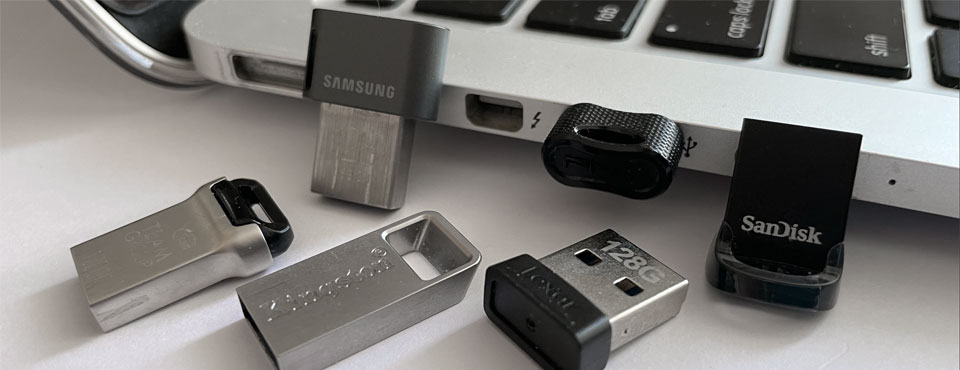
July 2022 Ian Chiu
We put five 128GB mini USB drives from Kingston, Lexar, PNY, Samsung, and Sandisk to test. Unlike thumb drives and portable SSDs, these compact drives by design can always stay plugged as a semi-permanent storage, yet fast enough for everyday tasks. In our July 2022 update, we added benchmarks for Kingston DataTraveler Micro which has received a major performance upgrade from the company.
Contents
Our Picks
If performance is above all else, Lexar JumpDrive S47 and Samsung FIT Plus are the ones to go for as they come out on top in comparison to other mini USB drives in our tests. The S47, however, has an edge over the FIT Plus when it comes to write performance whereas the FIT Plus is faster in sequential read. But if you’re looking for a massive 512GB, then only the Samsung and PNY offer it. For the budget-conscious, either drive’s cost per gigabyte is also reasonably low considering its zippy performance. Perhaps our only complaint is the FIT Plus’s size being noticeably larger than the JumpDrive S47. The Lexar is backed by a 3-year warranty whereas the Samsung is protected by a 5-year warranty.
Who Would Need Such a Small Drive?
Buyers who want a drive that only protrudes as little as possible from a USB port should consider one. Thumb drives in general stick out quite conspicuously so they could easily get bent when being bumped repeatedly. This could easily result in data loss and maybe even worse, a broken USB port.
By design, compact drives can always stay inserted into a USB-enabled car stereo or into a notebook as semi-permanent storage for media. They can also free up precious space on the laptop’s speedy SSD for mission-critical tasks. For this reason, a mini USB drive can actually prove to be quite practical for some of us who might need an effortless storage expansion option.
Feature Comparison
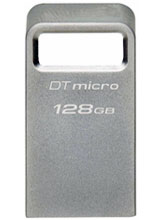 Kingston DT Micro $19.49 for 128GB | 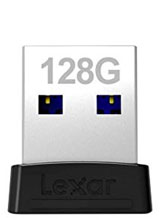 Lexar JumpDrive S47 $14.99 for 128GB | 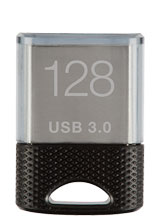 PNY Elite-X FIT $14.99 for 128GB | 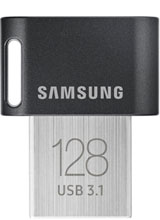 Samsung FIT Plus USB 3.1 $17.99 for 128GB | 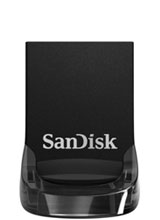 Sandisk Ultra Fit 3.1 $13.92 for 128GB |
|
| Read Speed: (10GB video) | 202.51MB/s | 241.13MB/s | 199.64MB/s | 293.54MB/s | 137.21MB/s |
| Write Speed: (10GB video) | 32.82MB/s | 57.75MB/s | 37.58MB/s | 42.31MB/s | 23.11MB/s |
| Read Speed: (5GB photos) | 167.17MB/s | 160.39MB/s | 167.19MB/s | 172.39MB/s | 100.59MB/s |
| Write Speed: (5GB photos) | 27.37MB/s | 47.42MB/s | 30.21MB/s | 35.48MB/s | 11.96MB/s |
| Storage: | 64 - 256GB | 32 - 128GB | 32 - 512GB | 32 - 256GB | 16 - 512GB |
| Interface: | USB 3.2 Gen 1 | USB 3.2 Gen 1 | USB 3.2 Gen 1 | USB 3.2 Gen 1 | USB 3.2 Gen 1 |
| Dimensions: | 25 x 12.2 x 4.5mm | 17.3 x 15 x 7.5mm | 20.8 x 15.2 x 6.4mm | 23.6 x 18.8 x 7.8mm | 19.1 x 15.9 x 8.8mm |
| Build Material: | Aluminum body | Plastic grip, aluminum body | Plastic grip, aluminum body | Plastic grip, aluminum body | Plastic body |
| Activity Light? | No | No | No | No | No |
| End Cap? | No | No | Yes | No | No |
| Color(s): | Silver | Black | Black | Gray | Black |
| May 2022 | Oct 2019 | Aug 2016 | June 2018 | Jan 2018 | |
| Warranty: | 5 years | 3 years | 1 year | 5 years | 5 years |
Pricing is last updated by Amazon on 2024-04-18 at 15:25. When you buy through Amazon affiliate links on our site, we may earn an affiliate commission.
Benchmark Analysis
Through Nodesoft’s DiskBench, our large file (10GB MP4) transfer tests have proved that Samsung’s FIT Plus was an undisputed leader in sequential read and that the Lexar’s second-generation mini drive – JumpDrive S47 – was the best in write performance. Our other test, which involved copying back and forth 5GB JPEGs (most of them being between 4 and 8MB), revealed similar results showing Lexar and Samsung outperforming others. It’s worth noting that Kingston updated their DataTraveler Micro in mid 2022. The silent upgrade doubles the speed of the aging mini drive and puts it in the same league as the PNY Elite-X FIT.
Samsung’s performance ratings vary between different capacities. The 32GB and 64GB models can reach up to 200MB/s whereas the 128GB and 256GB versions can do 300MB/s. Lexar claimed its drive can hit 250MB/s which is pretty close to what our S47 achieved in this benchmark. Lastly, we noticed that Sandisk exhibited performance inconsistencies during write operations. Our Ultra Fit would actually drop to below 10MB/s before slowly returning to above 30MB/s. The same thing didn’t happen with the other drives we’ve tested
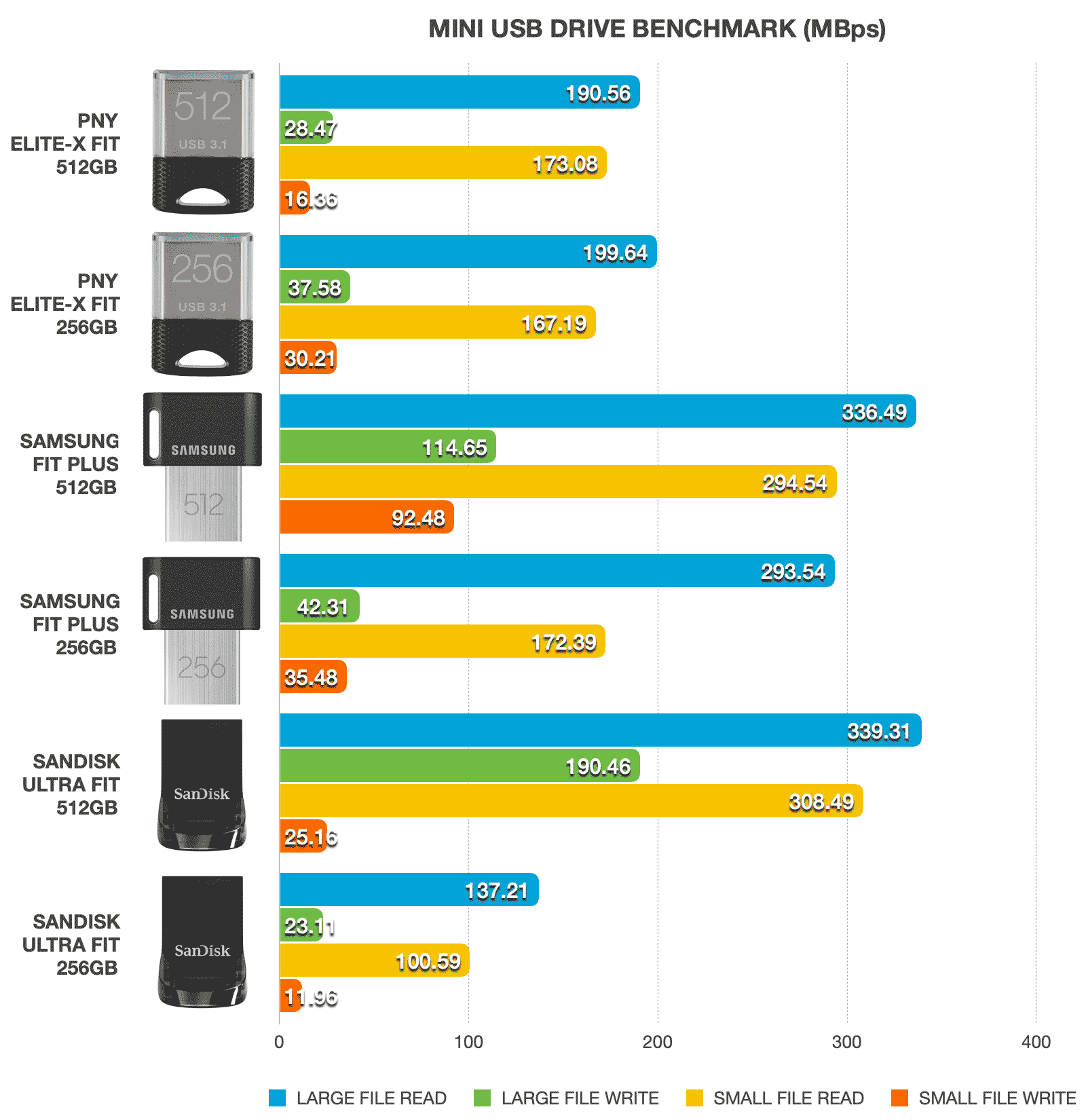
Note these two tests focused primarily on sequential performance, because we felt most people would rely on a mini drive primarily as intermediary or secondary storage for media data. These mini drives, without a decent flash controller, are inherently incapable of handling applications that require fast random access. For this reason, we didn’t bother with additional testing.
Design & Build
The featured low-profile USB drives are all similarly small, but as soon as they are put next to each other, the Lexar JumpDrive S47’s diminutive size compares favorably to others – even if only by a fraction. When inserted, the Lexar only protrudes just 5mm from the edge of a laptop as shown in the picture below. This makes the drive easily a no-brainer choice for an add-on drive for semi-permanent storage on your laptop. The second-best performer – Samsung FIT Plus – in comparison is noticeably larger, probably in favor of heat dissipation. All but Lexar have a keyring loophole if you need one.
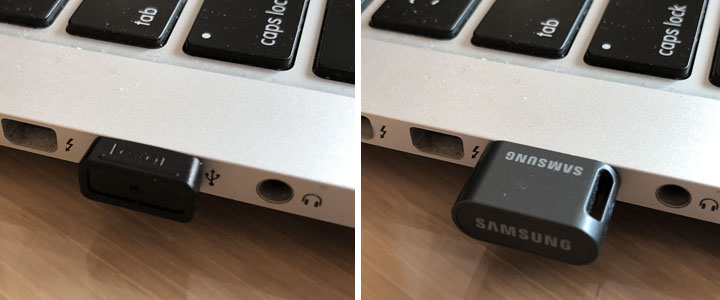
In terms of durability, Sandisk took a step backward with its squishy plastic connector with the latest version of Ultra Fit 3.1. This is a concern that is already echoed by a number of user reviews on Amazon. Having said that, if you intend to leave the drive plugged at all times, this shouldn’t be that big of a problem. We would have to say the other drives with their metal USB connectors protecting the flash components could likely survive if being stepped on.
Best Deals Online
| Preview | Product | Rating | Price | |
|---|---|---|---|---|

|
Kingston DataTraveler Micro 128GB USB Flash Drive | Ultra-Small Premium... | No ratings yet | $19.49 | See it on Amazon |

|
Lexar 128GB JumpDrive S47 USB 3.1 Flash Drive for Storage Expansion and... | No ratings yet |
$29.99
$14.99 |
See it on Amazon |

|
PNY 128GB Elite-X Fit USB 3.1 Flash Drive - 200MB/s, Silver | No ratings yet |
$14.99 |
See it on Amazon |

|
SAMSUNG FIT Plus 3.1 USB Flash Drive, 128GB, 400MB/s, Plug In and Stay,... | No ratings yet |
$17.99 |
See it on Amazon |

|
SanDisk 128GB Ultra Fit USB 3.1 Flash Drive - SDCZ430-128G-G46, Black | No ratings yet |
$37.99
$13.92 |
See it on Amazon |
Pricing is last updated by Amazon on 2024-04-18 at 15:25. When you buy through Amazon affiliate links on our site, we may earn an affiliate commission.
Nexcopy manufactures a variety of PC-based and standalone USB duplicator solutions.
PC based systems support advanced USB functions such as write protection, CD-ROM partition and multi-partition creation, while standalone systems are ultra-fast, high speed USB copiers duplicating gigabytes of data quickly and accurately.


Funny enough a few years later the only one that’s competitive currently is the Sandisk. Spec wise it’s about 3rd. Price wise it’s the cheapest one available by a very wide margin. The Sandisk clocks in about half the price of the others if you can even still find the others. Despite inconsistent reports of overheating issues it is tied for the longest warranty at 5 years. Unless you NEED that PNY performance (with just a 1 year warranty) I would recommend Sandisk.
Another one worth looking at, though is priced higher than the Sandisk, is the Mushkin enhanced atom. Seems to fall in line both spec and price wise with everything else on the list.=
Here in Canada, the Samsung is only $10 more. A price I’m willing to pay to avoid potential damage to my USB port from the Sandisk drive overheating.
I’m in Canada too. In my price hunting I found the SanDisk at 48$ and the Samsung is 74$. I understand you could have found a better price for the Samsung. I averaged prices when I claimed half the price. PNY I couldn’t find for under 100$ always looking for the 128GB and ignoring the rest.
I’d also like to address the overheating. I don’t think it’s happening anymore or is extremely rare. Looking at ratings the SanDisk has a higher rating on Amazon than the Samsung does, and you can bet everyone who had their computer melted rated it a 1*. So while the reports are things that exist I don’t think it’s a real risk. At this point the Sandisk one has been out for 3.5ish years, there have been many revisions of it, it was likely an earlier revision that had the problem and even then it was likely rare.
Both Samsung and Sandisk are rated for 5 years so for my purposes I would say Samsung is my second choice.
the tests on my macbook are completely different, I get write speed of 90 MB with sandisk and 80 with Lexar
Nice guide, useful information 🙂
All of these have slow write speeds, despite USB 3.0 having been around for eons. #justshootme #willmooreslaweverapplytousb3pointohwritecontrollers
Can you add in the Strontium Nitro USB 128gb drive? Also could you please show a comparison of all the random IO speeds? I personally want to purchase the mini USB with the faster random read/write speeds. Raspberry Pi project….
Little tardy to the party but also check out the mushkin enhanced atom.
“no reason not to” is a double negative and means exactly the opposite of what you intended. 😛
no reason not to basically means a reason to, no?
i think not.
“I have no reason not to buy…Kingston” does not mean “I have reason to buy Kingston”.
I posted above, but yes, it is a literally device that implies you are compelled to buy a 128gb over other options.
You can read this reply I posted above for a further break down.
It may be a vapid and overused expression, but it definitely does not mean the opposite of what the other intended.
Think about it.
The other is suggesting you buy a 128gb. Because of the reasons they outline, they cannot find a reason why you SHOULD NOT buy a 128gb. So they are saying, you have NO reason NOT to buy one, therefore you should buy one.
Some people is saying you ‘have (a) reason not to buy a 128gb’
The author is saying you have NO ‘reason not to buy a 128gb’. Therefore you should buy one.
It may be a vapid and overused expression, but it definitely does not mean the opposite of what the other intended.
Think about it.
The other is suggesting you buy a 128gb. Because of the reasons they outline, they cannot find a reason why you SHOULD NOT buy a 128gb. So they are saying, you have NO reason NOT to buy one, therefore you should buy one.
Some people is saying you ‘have (a) reason not to buy a 128gb’
The author is saying you have NO ‘reason not to buy a 128gb’. Therefore you should buy one.
I think this website is getting paid by SanDisk, everything is mentioned but not the heating problem, do you guys know heating of USB drive will use more battery power i. e. 30% to 40%. So it becomes a problem with phones.
good point. it know from personal experience
Good reviews. I’m glad I went with the Sandisk Ultra Fit since it was also the cheapest small USB drive (128gb for $55) I could find in my local electronics store in Singapore. So far it works pretty fast, and it fits in well with my Surface Pro 4 when it’s inside the thick STM Dux case so it does not stick out much.
Hello, could you fit 2 sandisks ultra one next to the other in that macbook pro?
I believe two Ultra Fits will barely fit on MacBook Pro 15″ 2010. But I am certain two Lexar S45s will fit without a problem.
Hey Everything USB, can you please do a fresh review for 2016 of mini USB 3.0 drives? Also include the Samsung USB 3.0 FIT Drive and any other new entrants.
Very good question, I wonder what’s the best USB flash drive between SAMSUNG fit 128, LEXAR S45 128, or the SANDISK (that seems to be quickly very hot for a lot of users) I’m searching for a divice that’ll stay always plugged on my laptop to increrase my storage and complete my SSD 256 Gb)
If you plan on using the Lexar S45 for secondary storage, keep in mind that the overly bright activity light can be an annoyance.
I’m adding Lexar S45 64GB to the comparison but I have problem acquiring Samsung FIT.
The Sandisk Ultra Fit is always being rated highest in these comparison articles.
All they are doing is test it long enough to benchmark.
The SanDisk in a USB 3.0 port is ultra hot within 5 mins of transferring files and the longer it goes on the hotter it gets. There are cases of it frying the port. I have a pair of 64GB Ultra fit drives because they are more stable than the 128GB size. I have found out from experience they heat up like I read everywhere online on USB 3.0, but are fine in USB 2.0 ports besides the fact they are slower in these.
Many laptops have boot problems with these left in the ports too. My HP 8560w has 3TB of SDD storage and I wanted to use my 2 USB3 Ultrafit drives in it for a dumping ground for files to be processed on one of my other laptops wi9th Sneakernet.
First for those asking why such a short USB stick – I am a teacher using a school computer for over a year and half and I need something that I can take everywhere on campus and to home. I keep everything for my class and extra curriculum activities on my drive. This allows me great flexibility with data and convenience to be completely mobile. If I have a regular USB drive sticking out it would get destroyed in a short period of time and that is real experience. Second to the best unit I have found has been the Sandisk Cruzer Fit USB 64 GB.. It has preformed flawlessly and allows for everything I need to be mobile. I highly recommend.
Hi, forgive my bad english. Interesting test, but what about random 4k read/write? I need a fast USB drive to enhance storage capacity of a lenovo Yoga 300 (just 32gb, only 1 free! How they can sell that unusable thing?)) I tried a Kingston Hyper X, it’s very fast in sequential read/write, but very slow in random 4k, and even too large for a plug in and forget drive. The Sandisk Ultra Fit has perfect size, but it’s slower in sequential performace compared to the HyperX, so I think it’s even worse in random 4k. 🙁
I’m curious about this too. Large sequential transfers are easy, how is it at high IO tests and 4K random read/write?
What makes one drive faster than the other? The all have the same USB 3.0 interface. Do they use different memory? The controller? What??
Yes, controller and NAND. USB 3 is just the interface. If they had a 1TB/s interface they’d still only read and write at ~130, the bottleneck is elsewhere.
I have one of the Sandisk drives and I got a similar sized Leef drive. The Leef drive has an LCD activity light which illuminates the entire drive vice the small light on the Sandisk. I haven’t benchmarked them but they seem to be about the same speed.
Lol, this is exactly the flash drive that I owed. It is different brand though. Alpha USB, I am talking about the large one on a picture. It lasted for over 5 years until it fell under my car wheel 🙂 I never understood why someone would want to buy such a tiny USB Drives as these examples. They are so inconvenient and easy to lose. This is the model I have, it is not large and not small, I think such size is perfect and there is no need to make smaller.
https://uploads.disquscdn.com/images/292c86f4f64adaf16c4141922ab561a0a7c129e3d4bd6234b315dd5492aaa35b.jpg
Because you can leave them plugged in for extra storage.
Can you have two Sandisk Ultra Fit plugged in a Macbook Pro at the same time? Are they small enough?
I just bought Sandisk Ultra Fit, and it seems overheat fast while copying 20GB file. which make it disconnect without complete copying.
Hmm… I tested the Ultra Fit on Surface Pro 3 and MacBook Pro Retina (late 2013). Before completing these benchmarks, I repeatedly filled up the drive with my 40GB photo library. But I never had an issue with overheating let alone disconnecting on its own prematurely. Could you tell us more about your problem?
I have the 32GB model. and I tried to write (copying from local drive) one single file 20GB*. the write speed was 47MB/s ~ 30MB/s. but the drive become extremely hot for touching after 1 min of writing , then it disconnect. I tried this on different format i.e. NTFS, exFAT.
I was able to write the file on USB 2.0 without overheating. also I did tried to write the same file on USB 3.0 while pausing the process if the drive become too hot.
The drive didn’t seems to have issue reading the same file to my PC (copying it to local drive)
I believe this issue has relation to the drive and the type of files (not my PC).
_____________________________
*20GB was Guild Wars 2 Dat file.
*sorry for my bad english
I have bought the 128GB version of Sandisk Ultrafit and it does get quite heated when copying larger files or even when you leave it in the laptop for 3-4 hours.
One review of the Sandisk on B&H complains it runs too hot, something I have also experienced with previous generations of the design.
Apparently so does the Transcend. Sad really, I need a reliable small usb 3 stick.
Even larger drives (including the new Samsung 1TB USB SSD) seem to have that issue. The thermal dissipation on a usb stub-sized drive are never going to be enough, and market volume is not sufficient to justify the development of ultra-low-power controllers and NAND flash to minimize TDP.
On the plus side, heat actually improves the reliability of NAND flash.
Hi Fazal, do you mind to tell us more about how the heat improves the reliability of NAND flash? I really am interested to know more about it
https://arstechnica.com/science/2012/11/nand-flash-gets-baked-lives-longer/
Wow, thanks for the article. I’m going to starting baking old SSDs!
From your reference: “The modification is a complex one and required substantial engineering, but the results are impressive—a brief and restricted jolt at 800C appears to “heal” the flash cell, removing its retained charge. Macronix estimates that this can be done repeatedly as needed, leading to a flash cell that could potentially last for 100,000,000 cycles, instead
of the roughly 1,000 cycles that current 21nm TLC flash cells are rated to last.”
My guess is that the flash drive isn’t receiving a “brief and restricted 800*C (1,472*F) “jolt”” in the USB socket of your computer; if it is – then it probably doesn’t matter if the USB flash drive life is extended.
yeah this is why I am here looking for a replacement, the 32GB sandisk ultra fit I have gets WAY too hot for me to leave it the laptop permanently… this laptop does have a microsd slot, might get one of those instead (well as long as it can boot, which might be unlikely, oh well, figure it out eventually)
Finally a new posting. I thought you guys forgot the website entirely
Thanks for your comment. We are reviving the site after a 4 month long hiatus. Past evaluations of the site suggested a new editorial direction is necessary. This article is the first step in this direction.